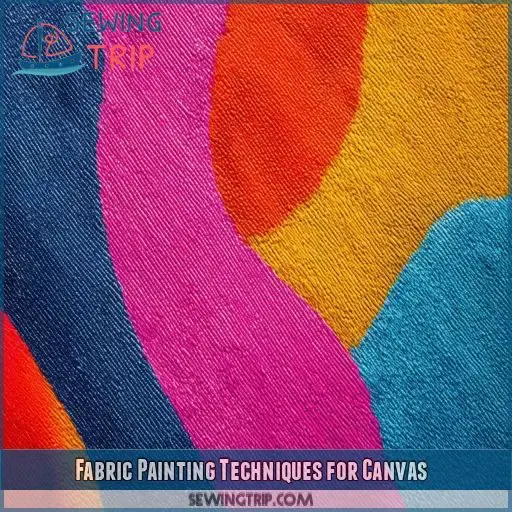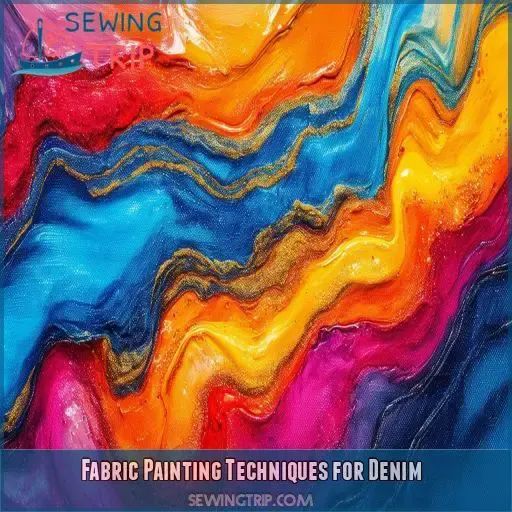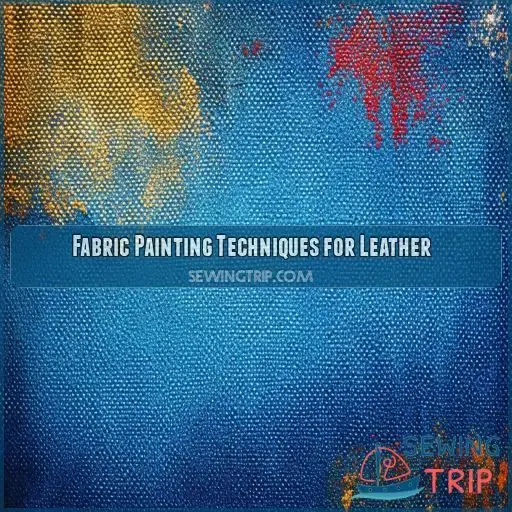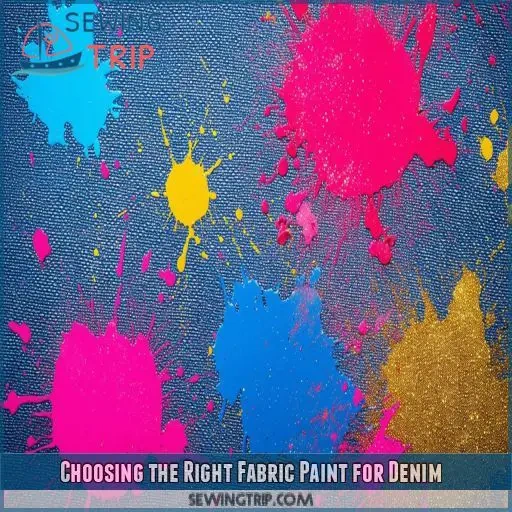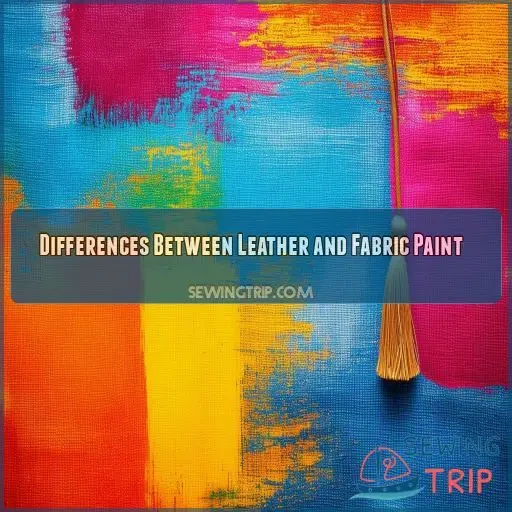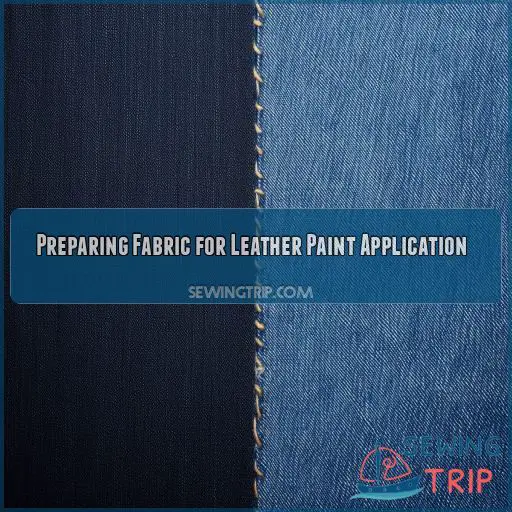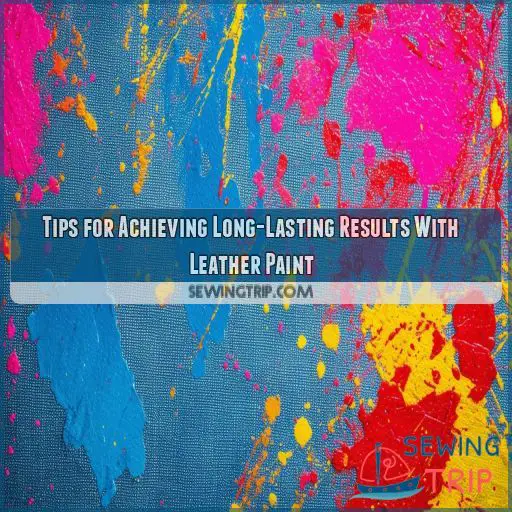This site is supported by our readers. We may earn a commission, at no cost to you, if you purchase through links.
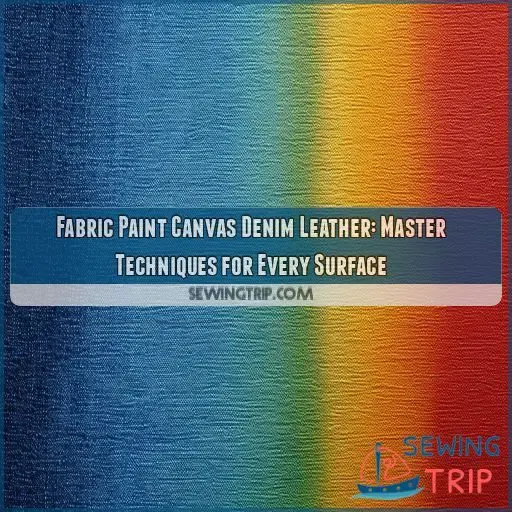
You’ll become proficient in techniques for every surface, transforming ordinary items into personalized masterpieces.
Learn how to select the appropriate paints, apply them effectively, and secure long-lasting results.
Whether you’re customizing a denim jacket, creating canvas art, or adding flair to leather accessories, this guide will empower you to take control of your designs.
Discover the secrets to vibrant colors, proper curing, and professional finishes.
It’s time to set your imagination free and leave your mark.
Table Of Contents
- Key Takeaways
- Fabric Painting Techniques for Canvas
- Fabric Painting Techniques for Denim
- Fabric Painting Techniques for Leather
- Choosing the Right Fabric Paint for Denim
- Applying Fabric Paint on Denim: Tips & Techniques
- Drying and Curing Fabric Paint on Denim
- Enhancing Fabric Paint on Denim: Color and Design
- Differences Between Leather and Fabric Paint
- Preparing Fabric for Leather Paint Application
- Tips for Achieving Long-Lasting Results With Leather Paint
- Frequently Asked Questions (FAQs)
- Conclusion
Key Takeaways
- Fabric paint sticks to a variety of surfaces, such as canvas, denim, and leather, allowing you to transform ordinary items into personalized masterpieces.
- Proper preparation is key: wash and prepare your surface, select the right paints, and apply them with specific techniques for each fabric type.
- Explore different finishes, textures, and color options to make your creations pop and express your inner artist.
- Understanding the differences between leather and fabric paint is essential for successful projects, ensuring adhesion, durability, and the desired aesthetic.
Fabric Painting Techniques for Canvas
Ready to transform your canvas fabric into a work of art? Let’s explore the realm of fabric painting! First and foremost, prepare your canvas by washing it and placing a barrier between the fabric and whatever lies beneath. Prime it with Gesso for an ideal foundation. Once dry, you’re ready to unleash your creativity.
Acrylic paint is your go-to for canvas, but remember to incorporate a textile medium for enhanced flexibility. Experiment with various brushstrokes to create texture and depth. Stenciling can add intricate designs, while color blending will impart a professional touch to your piece.
Need inspiration for your design? Explore nature, geometric shapes, or your preferred art styles. Remember, the key to stunning fabric art lies in meticulous preparation and allowing your imagination to soar. Happy painting!
Fabric Painting Techniques for Denim
Moving from canvas to denim, you’ll find this sturdy fabric offers unique challenges and opportunities. To start, prepare your denim by washing and drying it thoroughly. This removes any sizing that could interfere with paint adhesion. When choosing paints, opt for acrylic or fabric paints specifically designed for denim. These will flex with the fabric, preventing cracking.
Before diving in, consider these key techniques:
- Color mixing: Experiment with blending shades for custom hues
- Stencil options: Use pre-made or create your own for precise designs
- Paint application: Apply thin layers, building up color gradually
Don’t forget to add a textile medium to your acrylic paint. This improves flexibility and durability. As you work, remember that denim absorbs paint differently than canvas. You might need multiple coats for vibrant colors. Once your masterpiece is complete, heat-set it to make sure your design withstands wear and tear.
Fabric Painting Techniques for Leather
When painting leather, you’ll need to take a unique approach. First, choose leather-specific paints for the best adhesion and durability. Before you start, thoroughly clean the surface and remove any silicone coating. Test your paint on a scrap piece to make certain it behaves as expected. Sketch your design lightly with a pencil, then begin the fun part – painting!
Mix your colors carefully, as leather paint can be tricky to blend once applied. Apply thin, even layers, allowing each to dry completely before adding another. This technique prevents cracking and ensures a smooth finish. For added pizzazz, experiment with different finishes like matte or glossy.
Choosing the Right Fabric Paint for Denim
When selecting fabric paint for denim, you’ll want to evaluate its adhesion properties, resistance to washing, and color vibrancy options. These factors will guarantee your painted denim designs look great and endure regular wear and cleaning.
Paint Adhesion Properties
When selecting fabric paint for denim, paint adherence is paramount.
You’ll want to choose paints that bond with the fabric like a limpet to a rock.
Consider paint compatibility and appropriate paint thickness to guarantee your design’s longevity.
Gesso can enhance paint adhesion, but be mindful of fabric rigidity.
Don’t overlook curing and drying considerations—they’re essential for a durable masterpiece on your denim canvas.
Durability Against Washing
When choosing fabric paint for denim, essential against washing is substantially.
You’ll want to select paints that boast excellent wash resistance and colorfastness.
Test your chosen paint’s durability by applying it to a scrap piece of denim and running it through several wash cycles.
Look for paints specifically designed for fabric that offer water resistance and fade resistance.
Color Vibrancy Options
When choosing fabric paint for denim, you’ll find a world of color vibrancy options at your fingertips.
Experiment with color mixing to create unique shades, and don’t shy away from layering techniques for depth.
Try blending options to achieve gradients, or use stenciling effects for crisp designs.
For extra pop, consider embellishment ideas like glitter or metallic paints.
Applying Fabric Paint on Denim: Tips & Techniques
Now that you’ve chosen the right paint, it’s time to apply it to your denim canvas. Start by selecting a base layer that’ll enhance color vibrancy. Using a fabric medium can improve adhesion and prevent paint cracking as your denim moves. When mixing paint colors, remember that denim’s dark hue may require multiple layers for true vibrancy.
Here are some pro tips to elevate your denim painting game:
- Apply paint in thin, even layers to avoid stiffness
- Use a medium-firm brush to "scrub" paint into the fibers
- Experiment with textures using sponges or stencils
Drying and Curing Fabric Paint on Denim
After you’ve released your creativity on denim, it’s essential to master the drying and curing process. Don’t rush it! Proper drying prevents paint cracking and guarantees your design endures. Lay your painted denim flat, avoiding contact with other surfaces. Drying time variations depend on paint thickness and humidity, but generally allow 24-48 hours.
Once dry, it’s time for heat-setting methods to preserve your masterpiece. This step resists color fading challenges and enhances durability. Here’s a quick guide:
| Method | Temperature | Duration | Notes |
|---|---|---|---|
| Iron | Medium-High | 3-5 mins | Use parchment paper |
| Dryer | High | 30 mins | Tumble dry |
| Heat Press | 350°F | 15 secs | Professional option |
| Air Dry | Room temp | 7 days | For flexible paint alternatives |
| Hairdryer | High | 5-10 mins | Small areas only |
Enhancing Fabric Paint on Denim: Color and Design
Elevate your denim fabric painting game by exploring color combinations and design techniques that’ll make your creations pop. You’re not just painting; you’re expressing your inner artist. To enhance your fabric paint on denim:
- Play with contrasting colors for eye-catching designs
- Create texture using stippling, sponging, or brush stroke techniques
- Draw inspiration from nature, geometric shapes, or abstract patterns
- Experiment with layering colors for depth and dimension
Don’t be afraid to mix it up! Try combining bold primaries with softer pastels or create a monochromatic masterpiece. Remember, opacity is key on dark denim, so build up your layers gradually. For added pizzazz, incorporate stencils or freehand intricate patterns. You can even add sparkle with metallic paints or create a distressed look with strategic sanding. The denim is your canvas, and the possibilities are endless. Let your imagination run wild and watch your designs come to life!
Differences Between Leather and Fabric Paint
When you’re tackling leather versus fabric painting, it’s vital to understand their key differences. Leather paint is specifically formulated for better adhesion to smooth, non-porous surfaces, while fabric paint is designed for absorbent materials. Let’s break it down:
| Feature | Leather Paint | Fabric Paint |
|---|---|---|
| Adhesion | Strong on smooth surfaces | Better on porous fabrics |
| Durability | Highly resistant to wear | May fade with washing |
| Texture | Flexible, doesn’t crack | Can stiffen fabric |
Leather paint types include acrylic-based and urethane-based options, offering excellent durability and color retention. They’re often more opaque and require fewer coats than fabric paint. However, fabric paints typically provide a softer feel and better flexibility on clothing items. Remember, using the wrong paint can lead to peeling, cracking, or poor color payoff. So, always choose your paint wisely based on your project’s needs!
Preparing Fabric for Leather Paint Application
Now that you comprehend the fundamental disparities between leather and fabric paint, let’s explore preparing your leather surface for painting.
It’s imperative to execute this step effectively to guarantee your artwork endures.
Firstly, determine the type of leather you possess – is it smooth, suede, or a hybrid?
This will dictate your paint compatibility and primer selections.
Cleanse your leather thoroughly with a damp cloth and gentle soap, then allow it to dry completely.
For smooth leather, lightly sand the surface to enhance paint adherence.
If you’re working with treated leather, remove any protective coatings.
Always test your paint and primer on a small, inconspicuous area first.
This will assist you in avoiding any unpleasant surprises and confirm that your chosen products harmonize with your leather.
Ready to paint? Wait a moment!
Tips for Achieving Long-Lasting Results With Leather Paint
To guarantee your leather paint project withstands the passing of time, you’ll need to master a few imperative techniques. Commence by meticulously cleaning the leather surface, eliminating any oils or residues that might hinder paint adhesion. Select paints explicitly designed for leather, as they’re formulated to conform with the material without cracking. Regarding brush selection, choose soft, synthetic bristles that won’t mar the leather’s surface.
Here are three fundamental tips for enduring results:
- Always test your paint on a small, concealed area first
- Apply thin, uniform coats rather than one thick layer
- Seal your finished work with a leather-specific topcoat
Frequently Asked Questions (FAQs)
Will fabric paint stick to denim?
You’ve got it! Fabric paint sticks to denim like a charm. Just prep the surface, choose the right paint, and apply it carefully. With proper technique, you’ll create lasting designs that withstand wear and washing.
Does fabric paint stick to leather?
You’ll find fabric paint sticks well to leather, but you’ve got to prep it right. Clean the surface, remove any coatings, and use leather-specific paints for best results. It’s a bit tricky, but you’ll master it!
How do you paint a canvas to look like leather?
To transform your canvas into a leather-like masterpiece, you’ll want to start with a base coat of brown paint. Then, add texture using a sponge and darker shades. Finish by creating subtle creases with a dry brush technique.
How do you seal fabric paint on leather?
You’ll want to seal your fabric paint on leather for durability. Apply a thin layer of leather sealer or finisher over the dried paint. Use a soft brush, work in circular motions, and let it dry completely.
Can fabric paint be used on synthetic leather?
You can use fabric paint on synthetic leather, but it’s not ideal. For best results, choose a leather-specific paint or an acrylic designed for non-porous surfaces. Test a small area first and seal it properly afterwards.
How to remove fabric paint from denim accidentally?
You’ve got a denim dilemma. Don’t fret; you’re in control. Scrape off excess paint, then dab with rubbing alcohol. For stubborn stains, try acetone nail polish remover. Rinse thoroughly and wash as usual. You’ll conquer that paint in no time!
Are there eco-friendly alternatives to traditional fabric paints?
You’ll find eco-friendly fabric paint alternatives that’ll make your heart sing! Try natural dyes from plants, beets, or turmeric. There’s also milk paint, clay-based paints, and soy-based options. They’re gentler on the environment and your conscience.
Can fabric paint be used for tie-dye effects?
Yes, fabric paint can be used to create tie-dye effects. You’ll need to dilute the paint with water or a textile medium before applying it to the fabric. This technique produces a more controlled and crisper tie-dye effect than traditional dYes.
How to achieve a weathered look with fabric paint?
You can create a weathered look by lightly sanding the paint after it has dried.
Using a dry paintbrush, you can layer the paint and remove excess paint with light strokes to create the desired effect.
For a more controlled splatter effect, dip a stiff paintbrush into paint and scrape your finger along the bristles to flick droplets of paint over the fabric.
Conclusion
Now you’re equipped with the knowledge to transform ordinary fabrics into extraordinary works of art.
You’ve explored the nuances of fabric paint on canvas, denim, and leather, mastering the art of selecting the right paints, applying them skillfully, and ensuring long-lasting results.
With these techniques, you can personalize anything from denim jackets to leather accessories, letting your creativity soar and leaving your unique mark on the world.

